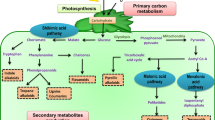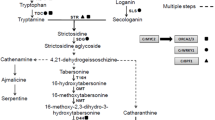Summary
While tube elongation of growing pollen ofCamellia japonica was stopped by treatment with 50–100 ppm of myrmicacin, protoplasmic movement in the pollen tube still continued. However, higher concentration (200 ppm) of the inhibitor arrested the movement. The vesicles containing membrane substances disappeared at the tip of the tube of the growth-inhibited pollen. Removal of the inhibitor resulted in the reappearance of the vesicles at the tip region and tube elongation was restored.
Similar content being viewed by others
References
Iwanami, Y., 1959: Physiological studies of pollen. J. Yokohama City Univ.116 (Biol.-13): 1–117.
—, 1978: Myrmicacin, a new inhibitor for mitotic progression after metaphase. Protoplasma95, 267–271.
—,Iwadare, T., 1978: Inhibiting effects of myrmicacin on pollen growth and pollen tube mitosis. Bot. Gaz.139, 42–45.
—, 1979: Inhibitory effects of myrmicacin on propagation of HeLa cells (in Japanese). Bull. Yokohama City Univ.30 (nat.-2), 168–172.
—,Iwadare, T., 1979: Myrmic acids: a group of new inhibitors analogous to myrmicacin (β-hydroxydecanoic acid). Bot. Gaz.140, 1–4.
—,Iwamatsu, M., Okada, I., Iwadare, T., 1979 a: Comparison of inhibiting effects of royal jelly acid and myrmicacin on germination ofCamellia sinensis pollen. Experientia35, 1311–1312.
—,Okada, I., Iwamatsu, M., Iwadare, T., 1979 b: Inhibiting effects of royal jelly acid, myrmicacin, and their homologous compounds on pollen germination, pollen tube elongation, and pollen tube mitosis. Cell Struct. Funct.4, 135–143.
-Tazawa, E.,Iwadare, T., Inhibiting effects of myrmicacin and homologous compounds on cleavage ofHemicentrotus pulcherrimus eggs. Cell Struct. Funct.4, 67–70.
Reynolds, E. S., 1963: The use of lead citrate at high pH as an electron, opaque stain in electron microscopy. J. Cell Biol.17, 208–112.
Rosen, W. G., Gawlik, S. R., 1965: Fine structure of lily pollen tubes following various fixation and staining procedures. Protoplasma61, 181–191.
Spurr, A. R., 1969: A low, viscosity epoxy resin embedding medium for electron microscopy. J. Ultrastruct. Res.26, 31–43.
Author information
Authors and Affiliations
Rights and permissions
About this article
Cite this article
Iwanami, Y., Nakamura, S., Miki-Hirosige, H. et al. Effects of myrmicacin (β-hydroxydecanoic acid) on protoplasmic movement and ultrastructure ofCamellia japonica pollen. Protoplasma 105, 341–345 (1981). https://doi.org/10.1007/BF01279231
Received:
Accepted:
Issue Date:
DOI: https://doi.org/10.1007/BF01279231




